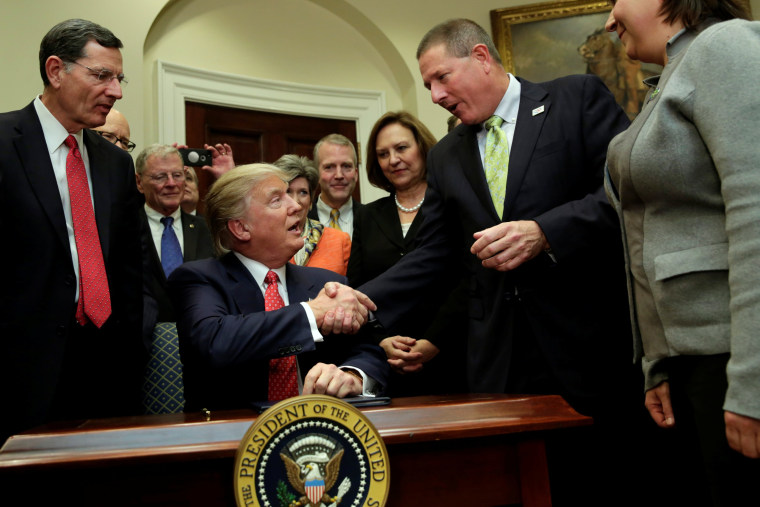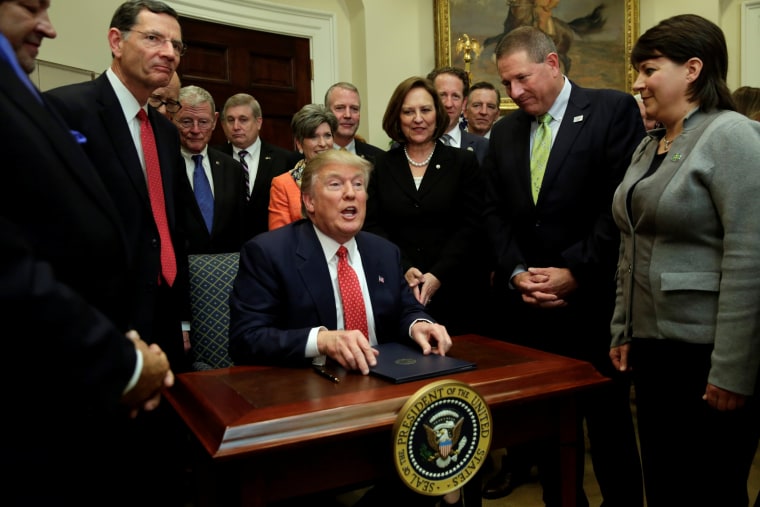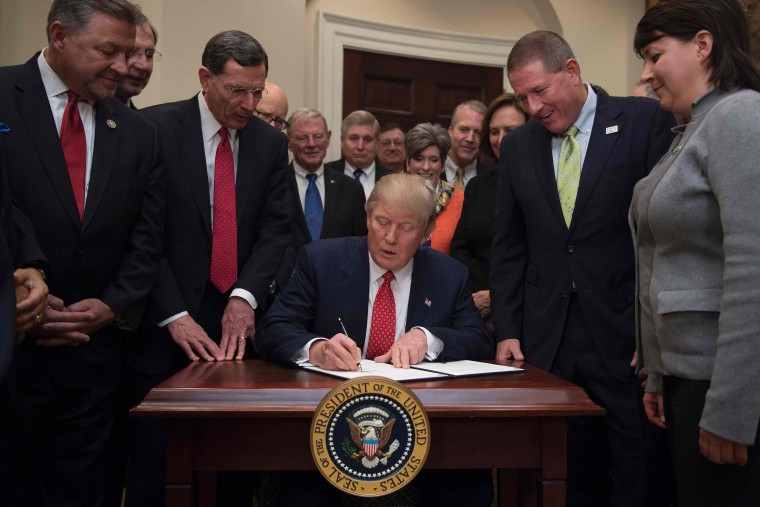President Donald Trump signed an executive order Tuesday aimed at rolling back an Obama-era rule that designates what smaller bodies of water, tributaries and wetlands are under the control of the Environmental Protection Agency and the Army Corps of Engineers.
The order instructs both departments to formally reconsider the Water of the United States rule or WOTUS. This could lead to a re-write of the law or a complete repeal, but could take a while to be implemented.
On Tuesday afternoon, Trump was surrounded by farmers, housing developers and county commissioners in the Roosevelt Room as he signed the order.
"The EPA so-called Waters of the United States rule is one of the worst examples of federal regulation, and it has truly run amok, and is one of the rules most strongly opposed by farmers, ranchers and agricultural workers all across our land," Trump said. "It’s prohibiting them from being allowed to do what they’re supposed to be doing. It has been a disaster."

Trump said the law meant that regulators had jurisdiction over puddles and ditches, but activists say this wasn’t allowed under the rule.
"With today’s executive order I’m directing the EPA to take action paving the way for the elimination of this very destructive and horrible rule," Trump said.
In addition to signing the WOTUS rollback, Trump also signed into law measures designed to promote women entering science, technology, engineering, and math (or STEM) fields, called the INSPIRE Women Act. The act encourages NASA to recruit women to STEM-related and aerospace positions.
He also signed a measure called the Promoting Women in Entrepreneurship Act, which Trump said enables the National Science Foundation to support women inventors.
The WOTUS executive order is aimed at undoing a rulesigned by President Obama in May of 2015, and went into effect in late August of 2015.
The rule intended to clarify what bodies of water were protected, according to the EPA, citing that 60 percent of the country's waterways and streams were vulnerable. Regulations would only become effective if one of those vulnerable areas was at risk of being polluted.
Related: Trump’s Big Promises Come Due In Major Congress Address
However, the law was soon after caught up in lawsuits, and in 2016, a nationwide stay on the law was put into effect.
Before the rule was stymied, it was met with opposition in the majority Republican Congress, and by Republican members of the Senate. They said they worried the law would create confusion as to which bodies of water were under federal jurisdiction and would negatively impact farmers, who believed puddles and streams on their property could be subjected to regulations.
Currently, the U.S. determines what waters are protected under a Bush-era law, according to Michael Kelly, director of communications at Clean Water Action.
Supporters of the Clean Water rule, like Kelly, say the law was instituted to protect drinking water and to advance the national goal of making all water In the United States “fishable, swimmable and drinkable.”

“Protecting clean water is about protecting public health,” Kelly told NBC News. “This executive order is putting our water at risk and putting special interests ahead of the public interest and ahead of the public health.”
Kelly said he believes misinformation surrounding the law led to some of the major opposition. He said although the law didn’t have much time to go into effect before it was stayed, it would have given more clarity to what water is protected and what waterways required things like construction permits.
“People would be able to know I can do this, and I can’t do this [in a body of water],” Kelly said. “It would be more regulated. We’d know our water is more protected, and we’d move closer to national goal of having water that is fishable, swimmable, and drinkable. The rule was a good step toward getting us there.”
He said Trump’s executive order is “putting industry that pollutes our water ahead of public health,” and called it “disturbing.”
Related: What is the Future for America’s Historically Black Colleges and Universities?
Friends of the Earth oceans campaigner Marissa Knodel said the executive order puts "American lives at risk so that polluters can profit."
The rule "is grounded in science and the law so that our streams and wetlands can keep us healthy and safe, provide habitat for fish and wildlife, and beautiful places to recreate," Knodel said. "In contrast, Trump’s dirty water order is dangerous and illegal, based on corporate greed and unlawful environmental pollution."
Scott Pruitt, Trump's EPA head, sued that agency when he was Oklahoma's attorney general in order to block to Clean Water rule.

But opponents of the law feel President Trump’s action is a relief to what they deemed a burdensome regulation.
"The flawed WOTUS rule has proven to be nothing more than a federal land grab, aimed at telling farmers and ranchers how to run their businesses," American Farm Bureau Federation President Zippy Duvall said in a statement emailed to NBC News. "The Environmental Protection Agency failed to listen to farmers' and ranchers' concerns when drafting the rule and instead created widespread confusion for agriculture. Under the rule, the smallest pond or ditch could be declared a federal waterway."
Duvall said farmers and ranchers are hoping for a common-sense approach to reforming clean water regulations. He added that the president has answered their call.
"EPA has too long been characterized by regulatory overreach that disregards the positive conservation efforts of farmers and threatens their very way of life," Duvall said. "Today’s action is as much a beginning as an end, and there is much work to do to ensure that any revised rule is transparent and fair for Americas farmers and ranchers."
